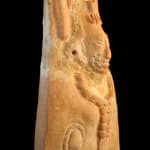Mayan Terracotta Sculpture, 500 CE - 900 CE
Terracotta
4 x 8.5
CK.0081
The Classic Maya period was an age of profound intellectual and artistic achievements, when the Maya built monumental pyramids and magnificent urban centers in homage to their gods. At a...
The Classic Maya period was an age of profound intellectual and artistic achievements, when the Maya built monumental pyramids and magnificent urban centers in homage to their gods. At a time when the Western world languished after the fall of the Roman Empire, the New World experienced an age of imperial grandeur, when great city-states like Tikal and Copán proclaimed Mayan hegemony over the emerald forests of Mexico and Guatemala. Theirs was a sophisticated but startlingly brutal civilization—wars were waged not for land or prestige, but for blood, for slaves sacrificed atop the great pyramids to appease the god’s insatiable lust for human flesh. The Mayan world was an arcane realm where the earth was contiguous with the heavens and the underworld. It was a society infused with spiritualism, a society that reflected both the majesty and savagery of the rain forests. Like the ancient societies of the Mediterranean, ceramic forms were vital to the Mayan economy and traded alongside coveted resources such as Jade, obsidian, flint, and shells.
Mayan art was composed of a complex symbolic language with deeply important social functions. Mainly commissioned by kings and other elite figures, works of Mayan art fulfilled both political and social purposes. Because the art functioned as a type of language, to be understood by the entire population, a certain consistency in subject matter and its portrayal was necessary. Whether on a cylinder vessel or a great mural, Maya art essentially depicts ritual. The impressive Maya ceremonies, recorded for posterity in their art, were crucial events in the lives of the kings, and consequently important to society as a whole. In Maya belief, an actual ritual ceremony is directly connected with the art which represents it; both conceived of as a power process that transformed spiritual beings into corporeal beings on the human level, and allowed people and objects to become the sacred beings they represented.
In the 9th and 10th centuries AD, the productivity of the southern regions went into decline for reasons that are still uncertain (although ecological causes are the likeliest option), although the northern areas continued to flourish on a reduced scale until the arrival of European forces and the subsequent decimation of Native American cultures across both continents. What is left, however – particularly dating to the Classic Period – includes art and other achievements that many consider to be the most refined and beautiful of the ancient New World. Stucco, mural painting (notably with the use of “Maya Blue”, the secret of which has been lost since the 16th century) and sculpture were all of an astounding quality and naturalism, with some sophisticated expressionistic tendencies.
This terracotta sculpture is a perfect example of the sophisticated naturalism that characterizes the Mayan style. The figure wears an elaborate costume, including a high arching headdress and long flowing robe, the contours of which define the shape of the sculpture. Decorative jewelry further adorns the figure, including a large beaded necklace and earspools. Such jewelry also confirms the figures high-ranking status among the Mayan elite, a rank further reinforced by the scarification bumps present on the figure's cheeks. Such a figure may represent a priest and a sculpture such as this may have been left as a votive in a temple or revered within the confines of a private home.
Mayan art was composed of a complex symbolic language with deeply important social functions. Mainly commissioned by kings and other elite figures, works of Mayan art fulfilled both political and social purposes. Because the art functioned as a type of language, to be understood by the entire population, a certain consistency in subject matter and its portrayal was necessary. Whether on a cylinder vessel or a great mural, Maya art essentially depicts ritual. The impressive Maya ceremonies, recorded for posterity in their art, were crucial events in the lives of the kings, and consequently important to society as a whole. In Maya belief, an actual ritual ceremony is directly connected with the art which represents it; both conceived of as a power process that transformed spiritual beings into corporeal beings on the human level, and allowed people and objects to become the sacred beings they represented.
In the 9th and 10th centuries AD, the productivity of the southern regions went into decline for reasons that are still uncertain (although ecological causes are the likeliest option), although the northern areas continued to flourish on a reduced scale until the arrival of European forces and the subsequent decimation of Native American cultures across both continents. What is left, however – particularly dating to the Classic Period – includes art and other achievements that many consider to be the most refined and beautiful of the ancient New World. Stucco, mural painting (notably with the use of “Maya Blue”, the secret of which has been lost since the 16th century) and sculpture were all of an astounding quality and naturalism, with some sophisticated expressionistic tendencies.
This terracotta sculpture is a perfect example of the sophisticated naturalism that characterizes the Mayan style. The figure wears an elaborate costume, including a high arching headdress and long flowing robe, the contours of which define the shape of the sculpture. Decorative jewelry further adorns the figure, including a large beaded necklace and earspools. Such jewelry also confirms the figures high-ranking status among the Mayan elite, a rank further reinforced by the scarification bumps present on the figure's cheeks. Such a figure may represent a priest and a sculpture such as this may have been left as a votive in a temple or revered within the confines of a private home.



